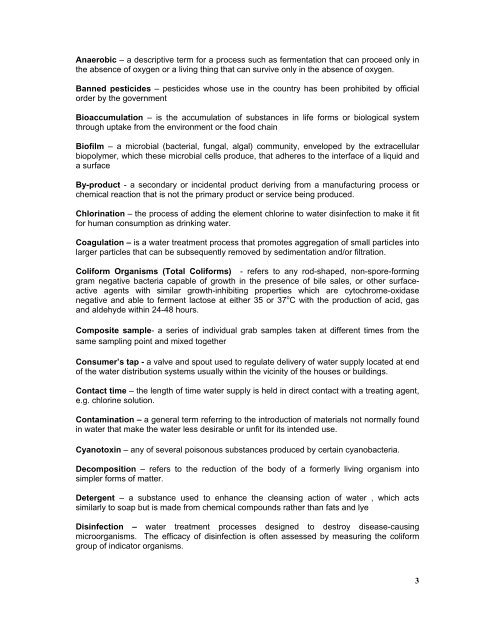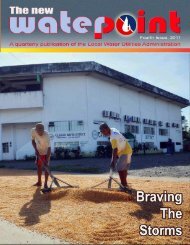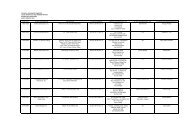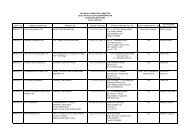Philippine National Standards for Drinking Water - LWUA
Philippine National Standards for Drinking Water - LWUA
Philippine National Standards for Drinking Water - LWUA
Create successful ePaper yourself
Turn your PDF publications into a flip-book with our unique Google optimized e-Paper software.
Anaerobic – a descriptive term <strong>for</strong> a process such as fermentation that can proceed only in<br />
the absence of oxygen or a living thing that can survive only in the absence of oxygen.<br />
Banned pesticides – pesticides whose use in the country has been prohibited by official<br />
order by the government<br />
Bioaccumulation – is the accumulation of substances in life <strong>for</strong>ms or biological system<br />
through uptake from the environment or the food chain<br />
Biofilm – a microbial (bacterial, fungal, algal) community, enveloped by the extracellular<br />
biopolymer, which these microbial cells produce, that adheres to the interface of a liquid and<br />
a surface<br />
By-product - a secondary or incidental product deriving from a manufacturing process or<br />
chemical reaction that is not the primary product or service being produced.<br />
Chlorination – the process of adding the element chlorine to water disinfection to make it fit<br />
<strong>for</strong> human consumption as drinking water.<br />
Coagulation – is a water treatment process that promotes aggregation of small particles into<br />
larger particles that can be subsequently removed by sedimentation and/or filtration.<br />
Coli<strong>for</strong>m Organisms (Total Coli<strong>for</strong>ms) - refers to any rod-shaped, non-spore-<strong>for</strong>ming<br />
gram negative bacteria capable of growth in the presence of bile sales, or other surfaceactive<br />
agents with similar growth-inhibiting properties which are cytochrome-oxidase<br />
negative and able to ferment lactose at either 35 or 37 o C with the production of acid, gas<br />
and aldehyde within 24-48 hours.<br />
Composite sample- a series of individual grab samples taken at different times from the<br />
same sampling point and mixed together<br />
Consumer’s tap - a valve and spout used to regulate delivery of water supply located at end<br />
of the water distribution systems usually within the vicinity of the houses or buildings.<br />
Contact time – the length of time water supply is held in direct contact with a treating agent,<br />
e.g. chlorine solution.<br />
Contamination – a general term referring to the introduction of materials not normally found<br />
in water that make the water less desirable or unfit <strong>for</strong> its intended use.<br />
Cyanotoxin – any of several poisonous substances produced by certain cyanobacteria.<br />
Decomposition – refers to the reduction of the body of a <strong>for</strong>merly living organism into<br />
simpler <strong>for</strong>ms of matter.<br />
Detergent – a substance used to enhance the cleansing action of water , which acts<br />
similarly to soap but is made from chemical compounds rather than fats and lye<br />
Disinfection – water treatment processes designed to destroy disease-causing<br />
microorganisms. The efficacy of disinfection is often assessed by measuring the coli<strong>for</strong>m<br />
group of indicator organisms.<br />
3







